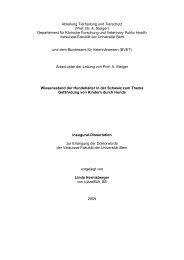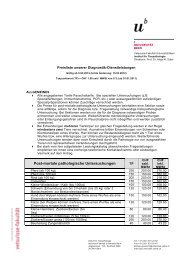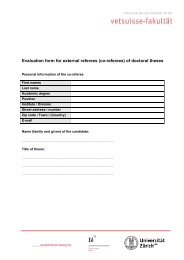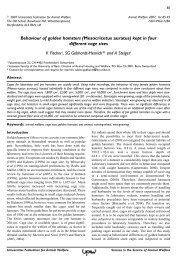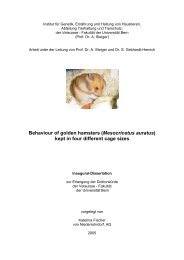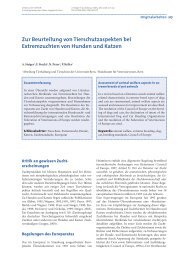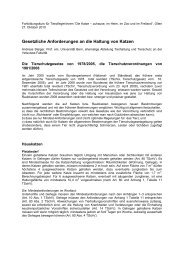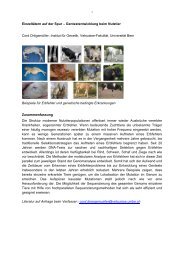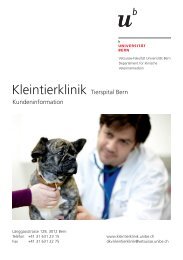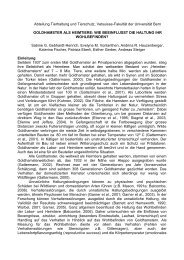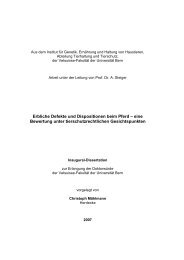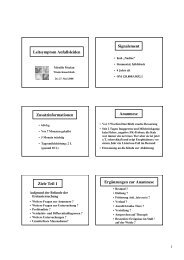Lifespan and Causes of Death in the Irish Wolfhound - Vetsuisse ...
Lifespan and Causes of Death in the Irish Wolfhound - Vetsuisse ...
Lifespan and Causes of Death in the Irish Wolfhound - Vetsuisse ...
You also want an ePaper? Increase the reach of your titles
YUMPU automatically turns print PDFs into web optimized ePapers that Google loves.
3.5.1.3 Diagnosis<br />
The history <strong>and</strong> cl<strong>in</strong>ical presentation <strong>of</strong> GDV cases is usually fairly characteristic <strong>of</strong><br />
<strong>the</strong> disease. If <strong>the</strong> state <strong>of</strong> <strong>the</strong> patient allows for an X-ray to be taken (right lateral<br />
recumbency), torsion can be differentiated from simple dilation us<strong>in</strong>g this method.<br />
The dilated <strong>and</strong> torsed stomach usually exhibits <strong>the</strong> classical "double bubble" pattern<br />
(Waschak <strong>and</strong> Jergens 2004).<br />
3.5.1.4 Therapy<br />
Treatment only has a chance if action is taken promptly <strong>and</strong> purposefully. If <strong>the</strong><br />
practice is not equipped to perform an emergency operation, it is crucial to make a<br />
rapid diagnosis <strong>and</strong> <strong>in</strong>itiate emergency patient stabilisation before referr<strong>in</strong>g <strong>the</strong><br />
patient to an appropriately equipped cl<strong>in</strong>ic.<br />
Emergency stabilisation consists <strong>of</strong> decompression <strong>and</strong> shock treatment. At first,<br />
<strong>in</strong>itial decompression is achieved through percutaneous punction with a 1.2 mm (18<br />
Gauge) needle through <strong>the</strong> left flank. The needle is <strong>the</strong>n attached to a suction pump,<br />
<strong>and</strong> suction is cont<strong>in</strong>ued until operation <strong>in</strong> order to relieve <strong>the</strong> pressure on <strong>the</strong> ma<strong>in</strong><br />
ve<strong>in</strong>s <strong>and</strong> diaphragm.<br />
Alternatively, it is possible to try to achieve decompression through a thick<br />
oesophageal probe <strong>in</strong> <strong>the</strong> st<strong>and</strong><strong>in</strong>g, non-sedated or mildly sedated dog (Suter <strong>and</strong><br />
Niem<strong>and</strong> 2001 c; Waschak <strong>and</strong> Jergens 2004). This is reported to be rarely<br />
successful, although failure to reach <strong>the</strong> stomach can be considered diagnostic for<br />
complete torsion.<br />
Second, shock treatment should be <strong>in</strong>itiated by putt<strong>in</strong>g an i.v. ca<strong>the</strong>ter <strong>in</strong>to <strong>the</strong><br />
cephalic ve<strong>in</strong> (alternatively, <strong>in</strong>to both cephalic ve<strong>in</strong>s to achieve faster adm<strong>in</strong>istration)<br />
<strong>and</strong> apply<strong>in</strong>g 7 ml/kg <strong>of</strong> a plasma exp<strong>and</strong>er, mixed with 20 ml/kg <strong>of</strong> R<strong>in</strong>ger lactate. 4<br />
mg/kg each <strong>of</strong> gentamyc<strong>in</strong> <strong>and</strong> dexamethasone can also be added. Us<strong>in</strong>g a caudal<br />
ve<strong>in</strong> (e.g. <strong>the</strong> V. saphena) for <strong>the</strong> <strong>in</strong>fusion is contra<strong>in</strong>dicated, s<strong>in</strong>ce <strong>the</strong> caudal caval<br />
ve<strong>in</strong> is compressed by <strong>the</strong> dilated stomach (Suter <strong>and</strong> Niem<strong>and</strong> 2001 c).<br />
It should be noted that <strong>the</strong>re is some controversy about <strong>the</strong> order <strong>in</strong> which<br />
decompression <strong>and</strong> fluid <strong>the</strong>rapy should be <strong>in</strong>itiated. For example, Waschak <strong>and</strong><br />
Jergens (2004) f<strong>in</strong>d it preferable to attempt decompression only after <strong>the</strong> <strong>in</strong>itiation <strong>of</strong><br />
fluid <strong>the</strong>rapy.<br />
After stabilisation <strong>of</strong> <strong>the</strong> patient is achieved, surgical decompression, reposition <strong>and</strong><br />
gastropexy should be undertaken <strong>in</strong> an adequately equipped cl<strong>in</strong>ic. If <strong>the</strong> patient fails<br />
to respond to stabilisation measures, surgery should be <strong>in</strong>itiated as quickly as<br />
possible (Waschak <strong>and</strong> Jergens 2004).<br />
Several surgical techniques have been described <strong>in</strong> <strong>the</strong> literature. The follow<strong>in</strong>g<br />
technique is taken from Suter <strong>and</strong> Niem<strong>and</strong> (2001 c):<br />
St<strong>and</strong>ard surgical preparation (shav<strong>in</strong>g, wash<strong>in</strong>g, <strong>in</strong>itial dis<strong>in</strong>fection etc.) is performed<br />
on <strong>the</strong> st<strong>and</strong><strong>in</strong>g animal under cont<strong>in</strong>uous <strong>in</strong>fusion <strong>and</strong> decompression. Inhalation<br />
anaes<strong>the</strong>sia (pure O 2 ) is comb<strong>in</strong>ed with neuroleptanalgesia (cave: drugs that may<br />
exacerbate hypovolaemia are counter<strong>in</strong>dicated, e.g. acepromaz<strong>in</strong>e). The dog is<br />
29



